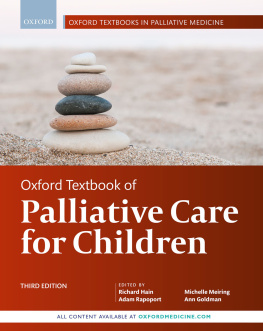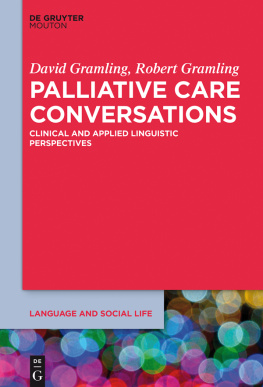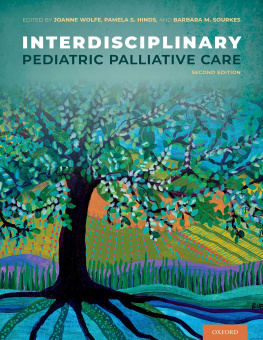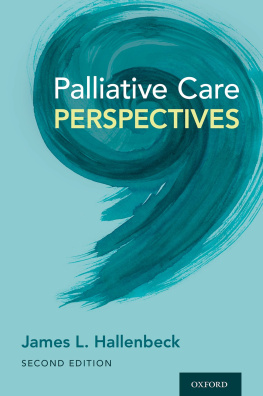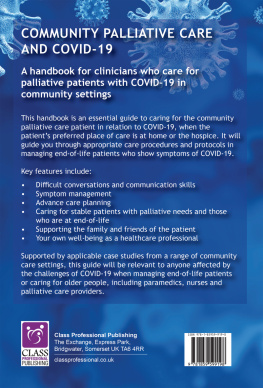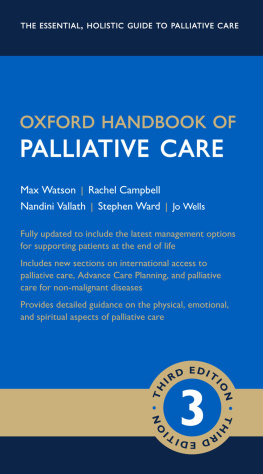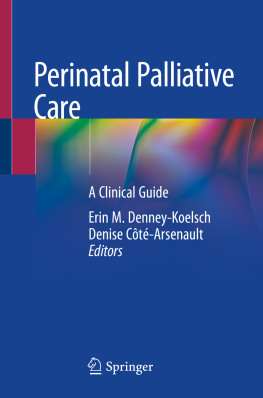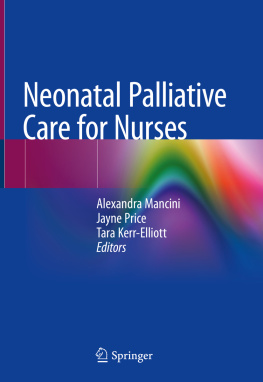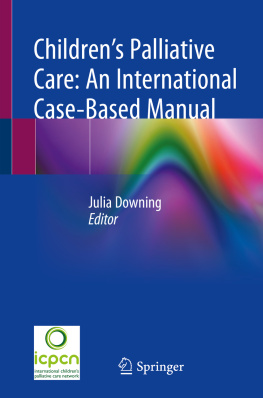Oxford Textbook of
Palliative Care for Children

Great Clarendon Street, Oxford, OX2 6DP,
United Kingdom
Oxford University Press is a department of the University of Oxford. It furthers the Universitys objective of excellence in research, scholarship, and education by publishing worldwide. Oxford is a registered trade mark of Oxford University Press in the UK and in certain other countries
Oxford University Press 2021
Appendix 1 2019 The Association of Paediatric Palliative Medicine (APPM)
The moral rights of the authors have been asserted
First Edition published in 2005
Second Edition published in 2012
Third Edition published in 2021
Impression: 1
All rights reserved. No part of this publication may be reproduced, stored in a retrieval system, or transmitted, in any form or by any means, without the prior permission in writing of Oxford University Press, or as expressly permitted by law, by licence or under terms agreed with the appropriate reprographics rights organization. Enquiries concerning reproduction outside the scope of the above should be sent to the Rights Department, Oxford University Press, at the address above
You must not circulate this work in any other form and you must impose this same condition on any acquirer
Published in the United States of America by Oxford University Press
198 Madison Avenue, New York, NY 10016, United States of America
British Library Cataloguing in Publication Data
Data available
Library of Congress Control Number: 2020944532
ISBN 9780198821311
eISBN 9780192554543
DOI: 10.1093/med/9780198821311.001.0001
Printed in Great Britain by
Bell & Bain Ltd., Glasgow
Oxford University Press makes no representation, express or implied, that the drug dosages in this book are correct. Readers must therefore always check the product information and clinical procedures with the most up-to-date published product information and data sheets provided by the manufacturers and the most recent codes of conduct and safety regulations. The authors and the publishers do not accept responsibility or legal liability for any errors in the text or for the misuse or misapplication of material in this work. Except where otherwise stated, drug dosages and recommendations are for the non-pregnant adult who is not breast-feeding
Links to third party websites are provided by Oxford in good faith and for information only. Oxford disclaims any responsibility for the materials contained in any third party website referenced in this work.
Preface
Bringing together this third edition of the Oxford Textbook of Palliative Care in Children has, as always, been both a delight and a challenge. It has been a delight to work with authors from every continent, drawn from almost every profession and discipline (including parents) that contribute to the care of children with life limiting conditions. To draw on the experience and knowledge of such a diverse range of contributors is essential in a book that claims, as this one does, to address the psychosocial and spiritual needs of children as well as the physical. It is impossible for any one profession on its own, let alone any one discipline within a profession, to offer the range of support that families need. It has been a privilege to work alongside so many who have chosen to apply their own professional and personal life skills to accompanying families through the worst time of their lives.
It has also, of course, also been an enormous challenge to produce a book that claims (again as this one does) both to be globally relevant, and at the same time to be informed by the most reliable and up-to-date knowledge and evidence available. The underlying philosophies of palliative care do not change with geography. The aim of palliative care is to ensure as far as possible the comfort and wellbeing of a child and family even though the child has a condition that cannot be cured and will ultimately result in a premature end to her life. Its aim is neither to hasten nor to delay death, but to improve the quality of the child and familys lived existence while dying occurs. The principles of child- and family-centred care that is flexible and individualised, of teamwork, and of evidence-based and reflective practice are similarly universal.
The ways in which those general principles have to be worked out in practice, however, certainly do depend on geography. Our editorial team now includes colleagues from Europe, North America, and Africa and, in this edition, we have tried to acknowledge the very different cultural, political and especially resource contexts in which paediatric palliative care must be delivered in different countries. To that end, we have recruited authors from all over the world and have tried to preserve authors original voices where we could. While we have encouraged authors to use terms that will be understood in the same way in every country, where possible we have also allowed local variations to stand. So, for example, the North American phrase critical care unit is used alongside the more usual neonatal or paediatric intensive care unit to describe critical care environments.
One term in particular deserves special mention because it is central to the theme of this book. The two phrases paediatric palliative care (PPC) and childrens palliative care (CPC) mean exactly the same thing, but we discovered that some contributors nevertheless had a strong preference for one over the other. The reasons were not always clear; some felt that childrens palliative care avoids an over-emphasis on physical interventions using medication prescribed by doctors, while others felt that paediatric palliative care is a useful reminder of the distinct nature of children, and of palliative care in children. For the purposes of this book, however, the editors consider the meanings of the two phrases to be identical. There may well be specific situations in which individual readers prefer one term over the other, but as descriptors of the work that this book is designed to support, they are interchangeable and the editors have left them as the authors wrote them.
The editors would like to record our enormous thanks and gratitude to Caroline Smith at Oxford University Press, who has patiently guided us from our first meeting in a garden in Wales one summer to the launch of the third edition of the Oxford Textbook of Palliative Care in Children. Our thanks also to previous editor Stephen Liben and to all the authors of earlier editions of the textbook, on whose foundations this latest edition is built. We hope the book will continue to be of value to all those caring for children and young people with life-threatening illnesses and their families; clinicians, volunteers, and families. We hope it will contribute to their skill and confidence and so help them ensure the children in their care can enjoy life even as they approach death, and can die peacefully and with dignity wherever they are.
Richard Hain
Ann Goldman
Adam Rapoport
Michelle Meiring
Contents
SECTION I
Foundations of care
Lorna Fraser, Stephen Connor, and Joan Marston
Jennifer Mack and Bryan Sisk
Robert Macauley and Richard Hain
Myra Bluebond-Langner and Richard Langner
Erica Brown, Mary Ann Muckaden, and Nokuzola Mndende
SECTION II
Child and family care
Nancy Contro and Jane Zimmerman
Myra Bluebond-Langner and Ignasi Clemente

